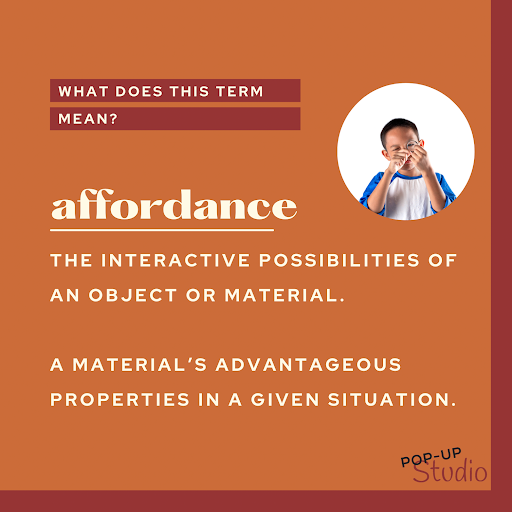Let’s deep dive into the term, “affordance.”
When designing hands-on, tactile learning experiences for our students, we want to reach for materials that are affordance-rich! But what does this term mean?
Affordances are the possibilities for actions between an individual and an object or material.
Where does the term “affordance” come from?
This term was coined by ecological psychologist J.J. Gibson (1977). In his chapter entitled, The Theory of Affordances, Gibson relates the term affordances to the ecological concept of niche. He writes, “Ecologists have the concept of a niche… a niche refers more to how an animal lives than to where it lives. I suggest that a niche is a set of affordances. The natural environment offers many ways of life, and different animals have different ways of life. The niche implies a kind of animal, and the animal implies a kind of niche. Note the complementarity of the two. But note also that the environment as a whole with its unlimited possibilities existed prior to animals and materials are not said to have affordances in isolation, but rather these are developed in reciprocal relationships with living things” (retrieved from https://cs.brown.edu/courses/cs137/2017/readings/Gibson-AFF.pdf)
How might considering affordances of materials or experiences matter to learning designers?
Different materials possess different affordances, and these are discovered in relationship with individuals.
What might this look like in practice?
A child may be able to think and express their ideas differently with different materials (E.g., paint, charcoal, and blocks all give rise to different ways of thinking).
For example, the affordances of a chair can be defined by the relationship between a person’s state or intentions and the characteristics of a chair. A tired individual can use a chair for rest whereas a person with a burnt-out lightbulb can use a chair as a step stool.
Materials in a classroom are moved, shaped, and transformed in many different ways because learners meet them in different states and with different intentions.
Try this!
What is a material that you have in your classroom that you can find LOTS of uses for? Pipe cleaners? Toilet paper rolls? Sticky notes? Paper clips? Comment below to share how you use this affordance-rich material!
Want to read more? Here are the sources that informed this post:
Gaver, W. (1991). Technology affordances. In: S. P. Robertson, G. M. Olson, & J. S. Olson (Eds.), Proceedings of the ACM CHI 91 Human Factors in Computing Systems Conference. April 28 – June 5, 1991 (pp. 79-84). New York: ACM.
Gibson J. J. (1977). The theory of affordances. In R. Shaw & J. Bransford (Eds.), Perceiving, Acting and Knowing (pp. 67-82). Hillsdale, NJ: Erlbaum.
Norman D. A. (1988) The psychology of everyday things. New York: Basic Books. 257 pages.
